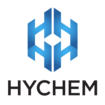Breaking the mould – increased flex for wastewater asset protection

Following the success of spray-applied epoxy coatings in the water and wastewater industries, it’s time to start delving into the possibilities of next generation epoxy resins, says Colin Murphy, Product Manager at Hychem. What will they be, how will they look and how will they break through current coating limitations?
According to Mr Murphy, increased crack prevention and increased impact resistance is the driving force behind the enhancement of protective coating technologies, especially within the wastewater industry.
“So far, protective coatings for wastewater assets have been highly successful in their resistance to chemicals and corrosion prevention of the asset.
“Products like Hychem’s TL5 has had 20 plus years of 100 per cent success, being used to coat concrete assets within harsh hydrogen sulphide environments in the water and wastewater industries.
“But as we now look to the future in next generation coatings, Hychem has taken the leap and manufactured an enhanced solution with greater flex capabilities – the Hychem TL5 IRF.
“Our TL5 product has coped very well since its first introduction, however, the flexible TL5 IRF may increase the options for different structures requiring a high build coating,” says Mr Murphy.
How will increased flex make a difference?
Increased flex of the epoxy resin will increase the coating’s ability to withstand a greater level of movement, opening up a variety of new applications where cracking may have previously become an issue overtime.
According to Mr Murphy, the increased flex of TL5 IRF will provide project managers with a longer lasting coating for a broader range of applications such as existing or new structures with anticipated movement.
“With a 40 per cent greater stretch capability than the original product, TL5 IRF will be able to adapt to any vibration present within manholes or sewer lines that sit in close proximity to main roads.
“The flexible nature of the product will allow energy from any impact to be dissipated, this makes it ideal for high impact areas like screening rooms or grit chambers.
“Structures subject to thermal changes from sunlight or other heat sources will also benefit from a flexible coating.
“In terms of coating strength, the TL5 IRF will be suited for coating steel, as traditional high build epoxies are often too brittle for the torsional forces in some of these structures,” said Mr Murphy.
No need to compromise
According to Mr Muphy, most flexible coating systems have a trade off with performance, typically to achieve a flexible finish.
“To achieve flexibility, most coatings are compromised on chemical resistance, durability and cure time.
“However the TL5 IRF will maintain very similar characteristics to the current TL5 of excellent chemical resistance, high durability and fast curing properties,” said Mr Murphy.
Versatility, chemical resistance and ease of application
According to Peter Clark, Managing Director at Peltos who has been using TL5 for concrete asset protection since its first introduction onto the market, the current TL5 epoxy has been so successful due to its versatility that he can only imagine the fantastic benefits of the new product.
“The best characteristic of the original TL5 epoxy is its ability to be spray-applied to a thickness of 6mm in one application, and that will remain for the new TL5 IRF.
“From an applicators perspective, this is a major benefit as it can provide a complete seal relatively quickly across the whole surface of the asset.
“Particularly in the water and wastewater industries, this single coat application means that any adhesion problems commonly associated with two-part epoxies simply don’t exist,” said Mr Clark.
TL5 IRF also has the same long-proven chemical resistance to sulphuric acid as the original TL5, which, so far, has not been beaten by any other product, said Mr Clark.
“TL5 was first formulated specifically for the wastewater industry and there are many structures coated around this time that are still in excellent condition today.
“TL5 will continue to be the product of choice in the harsh hydrogen sulphide environments, however TL5 IRF will offer an alternative for specific requirements.
“In fact, we are currently undertaking trials of TL5 IRF to be used in manhole situations involving heavy traffic on the road above, and other places where movement within the manhole is present such as subsiding land.
“It will be exciting to see how much of an impact the product’s increased flex will have on how applicators and project managers choose their coating solutions.
“TL5 IRF really is a next generation solution,” says Mr Clark.
Australian made, Australian owned
It is an added benefit that Hychem’s TL5 IRF is manufactured in Australia, said Mr Clark, as he can be certain that the product lives up to high safety and integrity standards.
“As TL5 IRF is made in Australia, I know that the materials used are of a high quality.
“And if I have any questions relating to the product or the way that it should be best applied, I can simply give the team at Hychem a call.
“The team know exactly what has gone into the product and understand its capacity from a design perspective, so I know they will provide me with a high level of technical support,” said Mr Clark.
